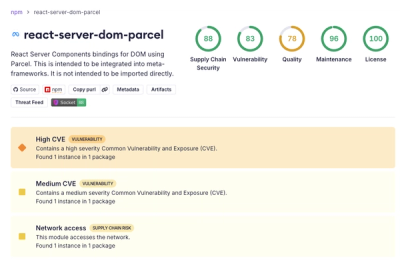
Security News
Deno 2.6 + Socket: Supply Chain Defense In Your CLI
Deno 2.6 introduces deno audit with a new --socket flag that plugs directly into Socket to bring supply chain security checks into the Deno CLI.
a11y-dialog-component
Advanced tools
Highly customizable accessible dialog library written in Vanilla JS
a11y-dialog-component is a fast, lightweight and flexible vanilla JavaScript library to create accessible modal, non-modal or tooltip dialogs.
These dialogs are fully accessible according to WAI-ARIA Authoring Practices 1.2.
A simple and fast way to get started is to include this script on your page. This will create the global variable
Dialog
<script src="https://cdn.jsdelivr.net/npm/a11y-dialog-component@5.5.1/dist/a11y-dialog-component.min.js"></script>
If you prefer to install a11y-dialog-component locally in your project, you can either:
Install with NPM
npm install a11y-dialog-component
Install with Yarn
yarn add a11y-dialog-component
Should you install a11y-dialog-component locally, you can import it as ES module like the following:
import Dialog from 'a11y-dialog-component';
It's also possible to use the require CommonJS syntax:
const Dialog = require('a11y-dialog-component').default;
Finally, let's create a basic dialog:
HTML
<!-- Opening trigger -->
<button type="button" class="js-dialog-open">Open dialog</button>
<!-- Dialog -->
<div class="c-dialog js-dialog">
<h2 id="dialog-title">Hello! I'm an accessible dialog</h2>
<button type="button" class="js-dialog-close">Cancel</button>
</div>
JavaScript
const dialog = new Dialog('.js-dialog', {
openingSelector: '.js-dialog-open',
closingSelector: '.js-dialog-close',
labelledby: 'dialog-title',
});
CSS
.c-dialog[aria-hidden='true'] {
display: none;
}
This previous code will generate an accessible dialog:
<!-- Opening trigger -->
<button type="button" class="js-dialog-open" aria-haspopup="dialog">Open dialog</button>
<!-- Dialog -->
<div
class="c-dialog js-dialog"
role="dialog"
tabindex="-1"
aria-hidden="true"
aria-modal="true"
aria-labelledby="dialog-title"
>
<h2 id="dialog-title">Hello! I'm an accessible dialog</h2>
<button type="button" class="js-dialog-close">Cancel</button>
</div>
Use the setDefaults() function to change the default configuration for dialogs. It will apply these settings to every
future instance.
import Dialog, { setDefaults } from 'a11y-dialog-component';
setDefaults({
documentSelector: '.js-page',
delay: 400,
});
Below is a list of all possible options to change the default configuration.
| Option | Default | Value | Description |
|---|---|---|---|
| documentSelector | .js-document | String | CSS selector used to target the main document. |
| documentDisabledClass | is-disabled | String | Add a class on the document (defined by documentSelector) while the dialog is open and if disableScroll: true. |
| openingTriggerActiveClass | is-active | String | Add a class on the opening trigger while the dialog is open. |
| delay | 200 | Number | Delay in ms once a trigger event is fired before the dialog autofocus. Usually matches with the CSS transition value to open or close this dialog. |
Below is a list of all possible options you can pass to a dialog.
| Option | Default | Value | Description |
|---|---|---|---|
| onOpen | noop | Function | Lifecycle function invoked when the dialog is opening. The function receives the dialog object as the first parameter and the opening trigger as the second parameter. |
| onClose | noop | Function | Lifecycle function invoked when the dialog is closing. The function receives the dialog object as the first parameter and the closing trigger as the second parameter. |
| openingSelector | "" | String | CSS selector used to open the dialog. |
| closingSelector | "" | String | CSS selector used to close the dialog. |
| backdropSelector | "" | String | CSS selector used to include a backdrop element which close the dialog on click. |
| helperSelector | "" | String | CSS selector used to add active class name(*) while the dialog is open. |
| labelledby | "" | String | ID selector to provide a dialog label (a11y compliant). |
| describedby | "" | String | ID selector to provide a dialog description (a11y compliant). |
| isModal | true | Boolean | If true, tells assistive technologies that the windows underneath the current dialog are not available for interaction aria-modal="true". |
| isTooltip | false | Boolean | If true, click outside the current dialog to close it. |
| isCreated | true | Boolean | If true, create the dialog when initialized. If disabled, then you need to create it manually by using create() method. |
| isOpen | false | Boolean | If true, open the dialog when initialized. |
| disableScroll | true | Boolean | If true, disable scrolling on the page while the dialog is open. |
| enableAutoFocus | true | Boolean | If true, focus moves to an element contained in the dialog when it opens. |
| openingTriggerActiveClass* | is-active | String | Add a class on the opening trigger and helper selectors while the dialog is open. |
| delay | 200 | Number | Delay in ms once a trigger event is fired before the dialog autofocus. Usually matches with the CSS transition value to open or close this dialog. |
Dialog instances have 5 methods available which allow you to control the dialog without the use of UI events.
Open the dialog
dialog.open();
Close the dialog
dialog.close();
Toggle the dialog
dialog.toggle();
Destroy the dialog
dialog.destroy();
Create the dialog
The create() method is automatically called on instantiation so there is no need to call it again directly (unless
you have destroyed the dialog previously).
dialog.create();
Didn't find the recipe that exactly matches your case? We have demos!
The demos folder contains 10 use cases of a11y-dialog-component. You might find there what you're looking for.
On production use files only from dist/ folder, there will be the most stable versions.
a11y-dialog-component uses Rollup to build a development and production versions.
npm install --global rollupgit clone https://github.com/jonathanlevaillant/a11y-dialog-component.gitnpm installnpm run dev
Development files (iife) will be available in demos/js/ folder.
npm run build
Production files (cjs, esm, iife) will be available in dist/ folder.
Please read CONTRIBUTING.md for details on our code of conduct, and the process for submitting pull requests to us.
We use SemVer for versioning. For the versions available, see the tags on this repository.
See also the list of contributors who participated in this project.
This project is licensed under the MIT License - see the LICENSE.md file for details
FAQs
Highly customizable accessible dialog library written in Vanilla JS
We found that a11y-dialog-component demonstrated a not healthy version release cadence and project activity because the last version was released a year ago. It has 1 open source maintainer collaborating on the project.
Did you know?

Socket for GitHub automatically highlights issues in each pull request and monitors the health of all your open source dependencies. Discover the contents of your packages and block harmful activity before you install or update your dependencies.

Security News
Deno 2.6 introduces deno audit with a new --socket flag that plugs directly into Socket to bring supply chain security checks into the Deno CLI.

Security News
New DoS and source code exposure bugs in React Server Components and Next.js: what’s affected and how to update safely.

Security News
Socket CEO Feross Aboukhadijeh joins Software Engineering Daily to discuss modern software supply chain attacks and rising AI-driven security risks.